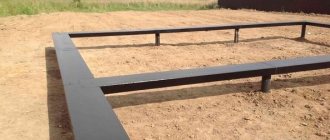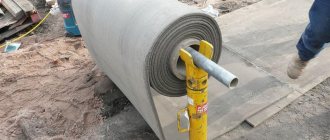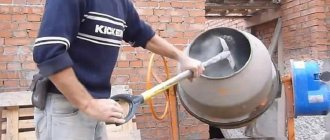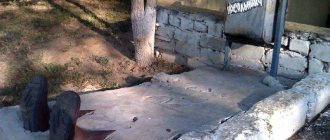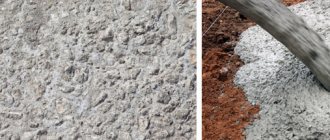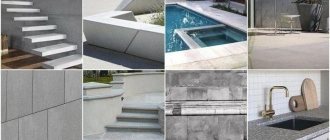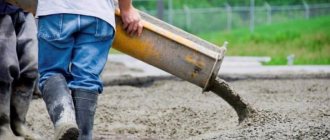Concrete is a universal building material that is used everywhere. In particular, it is used in monolithic multi-story construction, pouring foundations, producing concrete products, forming airfield runways, and building roads. In fact, it is a practical multi-component mixture that is gray in color.
However, recently, the material has begun to be used for the decorative design of buildings and structures.
For this purpose, architectural concrete is used (synonyms: arch concrete/polymer concrete/acrylic concrete/art concrete/art concrete/decorative/sculptural concrete) - a plastic mixture that allows you to create an imitation of natural coating, flat and volumetric decorations.
This material began to be used relatively recently, so it makes sense to get to know it in more detail.
What is it, scope of application of decorative concrete
As a building material, architectural concrete was patented in America around the mid- 60s of the last century. This mixture is created on the basis of cement with the addition of various types of fillers and coloring pigments. In essence, this is ordinary concrete, but there are a number of significant differences.
In particular:
- Fine-grained structure, which allows you to grind the surface to a perfectly smooth state.
- Low sorption humidity - the material maintains its integrity throughout its entire service life.
- Independence from sudden temperature changes.
- Neutrality to any environment.
It should be noted that concrete is available in a variety of colors, which provides almost limitless possibilities for architectural solutions. In addition, at the customer’s request, original fillers, for example, shells, can be added to architectural concrete.
If we talk about the scope of application, architectural concrete is used to perform the following work:
- Decorative finishing of interior spaces and external wall structures.
- Facade cladding.
- Casting sculptural forms.
- Bas-reliefs.
- Balustrades.
- Stairs.
- Terraces.
A key feature of architectural concrete is matrix finishing - pouring molds of varying textures to produce finished products of any shape.
Technology for creating objects from architectural concrete
The production of large concrete structures and structures is a labor-intensive process, and the construction of objects from architectural concrete without the use of special devices and technologies is impossible.
There are several main ways to make objects from art concrete:
- Using frame technology. As a rule, the frame is made of hand-made reinforcing mesh. The shape of the frame creates the basis for the future object.
- Pouring concrete into prepared forms. The forms are pre-made according to individual drawings and measurements or purchased ready-made if a standard design is sufficient.
- Using stencils. To create ornaments with a repeating pattern, special stencils are prepared, with the help of which a pattern or ornament is printed, or hand-cut according to an existing example.
If on a site or when decorating a room it is necessary to create concrete structures and structures according to individual drawings and sketches, then of the listed manufacturing methods, the only possible option will be to build the object from scratch using a frame. Let's figure out what stages the work to create such an object includes.
1st stage. Creating a wireframe
According to the project sketches, it is necessary to build the frame of the architectural structure. It is made of reinforcement, which is covered with a construction mesh with suitable cells. The mesh is fixed to prevent slipping.
To reduce the consumption of the mixture and create the correct shape of the structure, use a mesh with small cells.
2nd stage. Applying the first layer of architectural concrete
Next, you need to cover the frame with a layer of art concrete and give the product the necessary shape and bends. The work uses trowels, spatulas and palette knives. The result is a base consisting of a frame and reinforced concrete.
3rd stage. Applying a second layer of architectural concrete and artistic cutting
At the third stage, a top layer of concrete is applied, on which artistic cutting is carried out. The object acquires its final shape and appearance, details are smoothed out or, conversely, sharpened. At this stage, sculptors create cracks in the stone, relief of tree bark and other surface features, thanks to which a man-made product cannot be distinguished from one created by nature.
4th stage. Surface painting
After the object has completely dried and acquired a finished look and shape, they proceed to decoration. First, a primer (substrate) is applied, and then the paint is applied layer by layer using glazes, creating an imitation of the texture of natural stone, emphasizing bends, chips and cracks.
Advantages and disadvantages of artistic material
Despite its versatility and wide range of applications, architectural concrete is far from an ideal material. Let's start with the advantages.
The strengths of architectural concrete include the following parameters:
- High strength and resistance to dynamic loads. Thanks to this feature, the material can be used for decorative design of access roads to a country house.
- Resistance to aggressive environments. Concrete is neutral to acids and alkalis and does not collapse when exposed to moisture and high temperatures.
- Not susceptible to mechanical abrasion. Therefore, the material is often used as flooring on the first floors of shopping and entertainment centers and other buildings with high traffic volumes.
- Attractive price. Considering the wide range of architectural solutions, concrete is sold in an affordable price segment, which distinguishes it from natural materials.
- Long service life. To increase this characteristic, polymer fibers are added to the mixture.
Flaws:
- The manufacturing process involves the use of chemically active components, therefore architectural concrete is not considered environmentally friendly.
- When facing facades, the load on supporting and load-bearing structures increases significantly.
- Laying such a concrete mixture on your own is practically impossible: in order to preserve the texture, the work must be performed by qualified craftsmen, and this significantly increases the final cost of the material.
- Low pace of work: architectural concrete gains initial strength in about 48 hours .
- It is impossible to create small parts.
However, even a large number of disadvantages do not affect the popularity of architectural concrete in the domestic and world markets. In fact, this is an excellent alternative to natural finishing materials, helping to significantly reduce the cost of design of buildings and structures.
Varieties of arch concrete
Considering the versatility of its applications, architectural concrete is not a homogeneous gray mass, as many are accustomed to thinking about the material. The mixture produced is divided into three main groups. In particular:
- Geometric concrete is a multicomponent mixture for casting monolithic structures of any configuration in formwork.
- Decorative concrete is a mixture intended for finishing finished structures.
- Sculptural concrete is a mixture for casting artistic and volumetric decorations.
In addition, there are the following varieties on the market:
- White decorative: the main purpose is interior decoration, facade decoration. Restriction on operation – absence of high loads on the surface.
- Light white: a category of decorative concrete, which is used for casting volumetric decorative structures. The advantages of the mixture are an exact imitation of natural material.
The category of architectural concrete directly depends on the proportions of materials used to make the mixture.
What determines the choice of heating devices?
Heating appliances must meet specific design operating requirements. It is prohibited to use heating devices whose coolant temperature and pressure are lower than the required operating conditions for the network.
Disposal of radiators and convectors must be carried out in accordance with the regulatory documentation of the manufacturer.
To choose the right appliances for heating a home or industrial premises, you should rely on a number of criteria that will help you navigate the diversity.
- Economic. Any indoor heating system must maintain a balance between price and operational efficiency, and minimize installation and maintenance costs.
- Sanitary and hygienic. Heating devices must comply with sanitary and hygienic standards, maintain the temperature and humidity established in SanPiN, depending on the purpose of the room. They should not interfere with dust removal and serve as a source of pollution to the surrounding area.
- Stylistic and architectural. Much attention is paid to the stylistic orientation of the products. Heaters should fit harmoniously into the space and not take up much space.
- Assembly. Installing heating appliances should not be difficult and involve complex tools and highly paid personnel. Heating devices must be universal in mounting, have strong and reliable fastening methods.
- Operational. Modern heating products must comply with the parameters of the heat supply network. Have heat transfer adjustment to maintain comfortable indoor conditions.
- Thermal engineering. Heating devices must have maximum efficiency to maximize the use of coolant energy.
Disposal of heating devices
Source: https://zabor.bz/
Forming methods
Formation has its own characteristics and nuances. The following methods are used here:
- Throttling. The mixture is compacted by hand using iron reinforcement.
- Vibropressing. Vibrating tables are used here, the use of which makes it possible to achieve maximum strength.
- Pressing. In this case, molding is performed under high pressure, helping to create strong, thin-walled structures.
The strength and purpose of the material depends on the chosen molding method.
Forming methods
Pouring using a vibropress is a mechanical method of molding.
Concrete can be formed in several ways. Among them are:
- Tamping (stuffing) is manual work on materials, as a result of which rigid decorations are created. The essence of this process is to pour the solution and then tamp it using special devices - a rod or stick. In addition, it is possible to use vibration installations. This technology is used to create the most complex decorations. However, disadvantages should also be taken into account, including frequent cases of defects and low strength.
- Vibration pressing is performed by applying pressure during vibration. The tools of this method are vibropress and molds. This method of forming architectural products produces pavers, paving slabs, and other simple shapes. Polyurethane substrates play a role in improving surface quality. In addition, objects created using this method are highly durable, productive, and easy to manufacture. In addition, pigments can be used to achieve attractive tile colors.
- Pressing – the formation of products occurs using hydraulic presses and molds. This process is used to create thin-walled parts. Their features are high strength and frost resistance.
Return to contents
Composition and tables of proportions for preparing the mixture
Any concrete is a precisely adjusted proportion of materials that ensure the workability of the mixture and the strength of the structure. If we talk about decorative varieties of material, the composition will be as follows:
- Binding element
Cement of grades M-400/M-500 , without additional impurities and additives. In addition, given the purpose of the mixture, the cement must be white. - Filler
This component provides the volume and plasticity of the mixture. Most manufacturers use sifted quartz sand, which provides finished products with a texture identical to natural materials.
However, there are no strict recommendations or restrictions, so it is acceptable to use broken glass, marble chips, and river shells as filler. This helps to achieve original architectural effects.
- Crushed stone
In the production of conventional building concrete, this component provides strength. When making architectural concrete, adding crushed stone is not a prerequisite. However, many manufacturers take this step to improve the performance of the mixture.
- Supplements
It is allowed to use plasticizing additives and modifiers to improve the properties of the concrete mixture. The addition of additives improves the plasticity of concrete, increases frost resistance and moisture resistance, and allows you to achieve a glossy surface.
- Dyes
Dyes make the hardened concrete look like a natural coating. These components are added during the mixing process, which ensures uniform pigmentation. The color palette has no restrictions, so the shade of the finished product depends only on the desire and imagination of the customer.
- Water
This component is added to increase the plasticity and workability of the mixture. The presence of additional impurities in the water is not allowed: this can negatively affect the properties of concrete.
The proportion of components directly depends on the intended use of the concrete mixture. The ratio of filler, water plasticizers and binder is calculated in construction laboratories. The detailed manufacturing recipe is classified as a trade secret, so manufacturers are in no hurry to divulge their secrets.
Tables of ratios of parts of sand ( P ), cement M-400 and M-500 ( C ) and crushed stone ( SH ) for preparing arch concrete mortar:
| Cement M400 | |||
| Brand | Proportions C/P/SH | Volume of solution per 10 liters of cement, in liters: P/Sh | Liters of concrete made from 10 liters of cement |
| 100 | 1/4,6/7 | 41/61 | 78 |
| 150 | 1/3,5/5,7 | 32/50 | 64 |
| 200 | 1/2,8/4,8 | 25/42 | 54 |
| 250 | 1/2,1/3,9 | 19/34 | 43 |
| 300 | 1/19/3,7 | 17/32 | 41 |
| 400 | 1/1,2/2,7 | 11/24 | 31 |
| 450 | 1/1,1/2,5 | 10/22 | 29 |
| Cement M500 | |||
| Brand | Proportions C/P/SH | Volume of solution per 10 liters of cement, in liters: P/Sh | Liters of concrete made from 10 liters of cement |
| 100 | 1/5,8/81 | 53/71 | 90 |
| 150 | 1/4,5/6,6 | 40/58 | 73 |
| 200 | 1/3,5/5,6 | 32/49 | 62 |
| 250 | 1/2,6/4,5 | 24/39 | 50 |
| 300 | 1/2,4/4,3 | 22/37 | 47 |
| 400 | 1/1,6/32 | 14/28 | 36 |
| 450 | 1/1,4/2,9 | 12/25 | 32 |
Safety requirements for heating devices
The surface of convectors and radiators should not have sharp edges and be injury-proof.
If the technology provides for heating the surface of the heating device to a temperature exceeding 750C, then protective screens must be installed
To paint heating appliances, it is necessary to use powder, paint and varnish materials that do not emit harmful and toxic substances during operation.
The use of central heating batteries for grounding or conductive work is prohibited.
It is not allowed to release the air mixture from an aluminum device during operation if there is an open fire nearby.
How to make the material yourself
When decorating a country house, you don’t always need to buy material from the manufacturer. The technology for making the mixture is quite simple, so you can do the work yourself. Of course, each has secrets that set the product apart from its competitors. However, the key principles for making the mixture remain unchanged.
Here you need to follow the following sequence of actions:
- Preparation of cement-sand mixture in compliance with the standard proportion of 1:3 .
- Adding water. Liquid is added until the mixture reaches the desired mobility. In addition, at this stage the composition includes plasticizers and coloring agents.
- Adding cement. The content of this component should not exceed 40% of the total volume of the mixture. Input is also added here to make the concrete plastic and workable.
After this, the mixture is poured into ready-made molds of the desired configuration and carefully compacted to avoid the formation of voids. Further work can be carried out 48 hours after pouring; concrete needs 28 days .
How many heating devices are needed in the room?
Indoors, according to the technology for installing heating devices, it is necessary to install a heater under each window. Since the main purpose of heating devices is to compensate for heat loss, the power of the devices is based on the summation of heat loss coefficients. According to average thermal calculations, with a ceiling height of 2.7 m, 1 m3 of housing in a panel house requires 40 W of thermal energy, and a brick house requires 35 W. Based on this, you can calculate the total power of the heaters. The final result will be influenced by factors: the ratio of the area of the glazed surface to the area of the walls; the area of the external walls in the room and the degree of insulation, heat loss from the ceiling and floor, type of double-glazed window, amplitude of temperature fluctuations. In a private house, the heat loss coefficients of the roof and foundation are taken into account. Each factor is assigned a coefficient, which can be found in the tables for thermal engineering calculations.
How many heating devices are needed in the room?
Source: https://www.okna-21-veka.ru
Manufacturing plants
The demand for products made from decorative materials is rapidly gaining popularity, however, not all manufacturers produce such products. Among the trustworthy companies are the following:
- PLACHINTA . The plant is located in Crimea and produces high-strength architectural concrete for landscape design of recreation areas. In addition, the company's product range includes piece products of all shapes and sizes. Delivery is carried out throughout Russia.
- "Arbet" . The company is located in Moscow and offers customers any design options using the subject of our conversation. The manufacturer strictly monitors product quality, uses high-tech equipment, and attracts the attention of customers with competitive prices.
- "Decorstroy" . A Moscow company with one of the most powerful production bases in Russia. The technological process is carried out on certified equipment, GOST standards are strictly observed.
